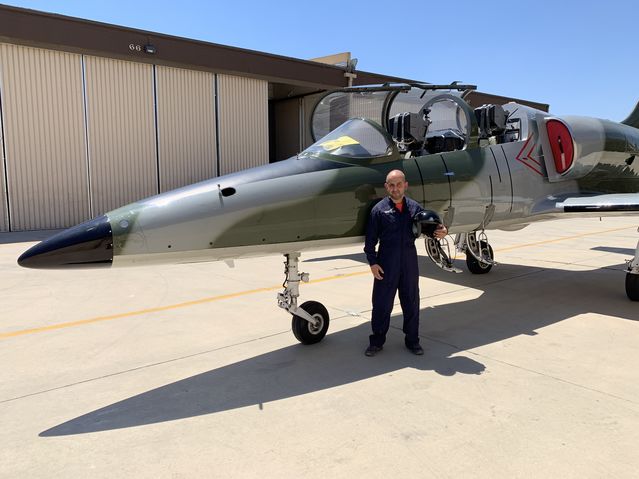Fear
How Flying in a Fighter Jet Affected My Mind and Body
A psychiatrist’s perspective on mental and physical aspects of flying a jet.
Posted September 8, 2019 Reviewed by Gary Drevitch

At 11 am on Aug 16, I arrived at a local airport near Los Angeles to meet Steve, a former Hungarian Air Force pilot. Steve was going to have me fly with him in an L-39 Albatross, a trainer resembling Russian MiG fighters. Since childhood, I have been fascinated by fighter jets and know a lot about them. I had signed up for the flight on a trip to LA for a conference. As an expert in neuroscience and the psychology of fear, I decided to observe my own mental and physical reactions, and see if my knowledge could help ease the experience.
Training: Social safety cue, preparedness, internal context, and knowledge
We are social animals, capable of learning from our conspecifics, an evolutionary advantage. We specifically learn fear and safety from other humans. That has helped our species survive, by not going through the same dangers experienced by our tribe mates, and not avoiding safe resources.
Steve spent a good amount of time teaching me about the flight, which was well paired with my excitement carried from childhood to this airport. This was important in reducing fear: The unknown is often scary, and the more we know, the less we fear. It all went well until he brought up the emergency exit plan: We would eject the canopy and jump out of the plane! Although I logically knew these planes are very safe and there were only a few reports of mishaps, I had read about one crash in California on Wikipedia! Here came the mental context one brings to the experience, paired with the physical context: The higher the risk, the less data we need to be terrified: One crash out of so many flights is negligible, but not when it comes to one’s own life. Logical brain, paired with my excitement, overturned the fear. Steve’s calm demeanor and sense of humor was a social safety signal to my animal brain
I found a fitting flight suit, tested the helmet, and sat in the co-pilot seat on the back. The back seat was originally designed for the instructor, and sits taller for a better front view.
The flight: Sense of control, 5G, confusion, and acrobatics
Takeoff was pretty quick and before I knew it, we were in the sky. There is a control stick for each pilot, and they move together. Steve advised me to hold the stick, and sense its motion as he steered the plane. Just doing that immediately provided me with a sense of control (although it was false), reducing the anxiety. After a while, he allowed me to steer the plane, just simple left and right and nose up. And then the party began.
Increased G-force was the hardest part of flying. According to Steve, a sharp turn or a climb could create somewhere between 2G to 5G. That means my 160 pound mass could feel near 800 pounds for a few seconds during these maneuvers! My body felt super heavy, my back pushing into the seat, and it was quite an effort to try to lift my arm! Blood is pushed down from the head, and one starts to feel dizzy; some people pass out. A few things were helpful: KNOWING this would be just a few seconds; Steve alerting me in advance of each maneuver (preparation); and my excitement (internal emotional context) — a combination of physical preparedness, knowledge, positive emotions, and social safety cues. Eastern European style, Steve was laid back, calm, and confident. During the rolls, barrel rolls, loops, Immelman turns, and split-Ss, I lost the sense of time and space. It was hard to find the horizon or to tell up from down. My body had not evolved to move and change direction at a speed above 450 mph! At one point, I reminded myself of Steve’s skills. He had done these maneuvers in MiG-29s (kind of like Russian F-18s). I chose to submit to his control: TRUST immediately reduced my anxiety. Interestingly, I was here at a Conference on Sufism, part of which teaches full submission to the higher power, and trusting that it will hold you safe.
Next, it was my turn to do the rolls. Steve was a great teacher: He trusted me (and let me trust myself) and gave me a better sense of control by lifting his hands off the stick, holding them where I could see them. Sense of control reduces anxiety, while its absence makes it worse. When I was doing the rolls, they were much easier; not only could my body predict the motions better, but I also I felt in charge.
Like any other activity, too much effort and holding body tight was another mistake. When scared, the body automatically switches to fight or flight mode, ready to react fast. The animal brain does not differentiate a condition in which such tension is not helpful. Quickly I learned that relaxing my body and going with the flow made it much easier. Stressed rapid breathing also does not help and makes one more dizzy and anxious: I slowed and deepened my breathing to calm the sympathetic nervous system.
Before the flight, I started a physical activity on my Apple watch to track my heart rate. I am pretty fit, box regularly, and my usual baseline heart rate is low 50s, peaking to high 170s during bag practice. During the 45-minute flight, it ranged between 89-121, clearly indicating moderate stress, with oscillations during maneuvers, partly due to stress, and partly due to the need to push the blood to my head during increased G-force periods.

The aftermath: flashbacks and the excitement
After landing, I was both physically and mentally exhausted and starting to feel nauseous. After intense experiences, whether traumatic or exciting, intrusive memories and flashbacks are common. This is how our brains process and consolidate the memories, and prepare to deal with similar conditions in the future. At the hotel I tried to take a nap. Between wakefulness and asleep, I kept experiencing somatosensory flashbacks of increased G, feeling as if my body was pushing hard into the mattress. When I fell asleep, repeated dreams of the increased G-force and being upside down woke me up. When younger, I had played a lot of flight simulation games, and my brain was familiar with the visuals. The most unusual and unfamiliar part of the experience was somatic, and hence there was more of the brain focus on processing that part.
The experience was condensed and fast, affecting so many sensory modalities, and its processing took some time: Part of me was in denial for a couple days, and I repeatedly found myself in awe, telling myself excitedly: Dude, I flew a fighter jet!
Overall, it took a couple days for my mind and body to come back to normal; it was a once in life experience, and it was amazing.




